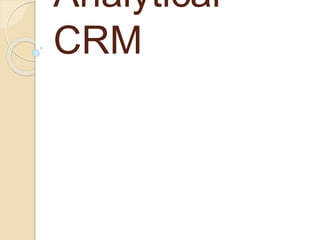
Analytical CRM.pptx
- 2. CUSTOMERS ARE VALUE MAXIMISERS AND RISK MINIMISERS
- 3. Relationship styles of customers Jones and Sasser (1995) in ‘Why satisfied customer defect’ published in HBR mentioned different customer behaves Apostels:- i) Completely satisfied ii) Keep returning to the company iii) Experience exceeds their expectations iv) Sahre their strong feelings with
- 4. Terrorists/Defectors:- i) More than dissatisfied, quite dissatisfied and neutral ii) Could be highly satisfied customers who have encountered failures iii) In service recovery these customers’ needs to be redressed to convert them into highly satisfied customers
- 5. Mercenaries:- i) May be completely satisfied but exhibits no loyalty ii) Expensive to acquire and quick to depart iii) Chase low prices, buy on impulse, pursue fashion trends or seek change for the sake of change
- 6. Hostages:- i) Customers of the companies operating in monopolistic environment ii) Habituate to a particular brand iii) Demonstrate inertia in brand switching iv) Accept the worst offer of the company
- 8. Reexamining Customer Segmentation Not all customers are equal Loyalty of customers is linked to profitability through: i) Length of relationship ii) Repurchase intent, or iii) Recommendations to others
- 9. Linking profitability and loyalty Butterflies good fit between customer’s offering and customer’s needs high profit potential • Strangers little fit between customer’s offering and customer’s needs lowest profit potential
- 10. • Barnacles limited fit between customer’s offering and customer’s needs low profit potential • True friends good fit between customer’s offering and customer’s needs highest profit potential
- 12. Customer Value: Concept and characteristics It is the customer’s perception of what outcome he expects in a specific use situation with the help of a product offering in order to accomplish a desired purpose Value is customer-defined Customers differ in who they are, what outcomes they seek, and what value they place on different benefits of an offering
- 13. Value is opaque Value is contextual Value is multidimensional Value is a trade-off Value is relative Value is mindset
- 14. Types of Customer Value Three roles customers play- user, payer and buyer Users seek performance, social and emotional value Payers want price value and credit and financing values Buyers look for service value and convenience and personalization value
- 15. Customers derive value from three sources – economic, functional and psychological Economic Value Psychological Value Functional Value
- 16. Economic Value: Net monetary advantage from using a product versus its alternatives over the life of the product Functional Value: Value provided by the performance features of a product Psychological Value: Focuses on intangibles such as brand names, images and associations with a certain brand
- 17. Other values • Choice based value: choices available to customer in terms of dealing with the company, payment for purchase etc. • Employee based value: providing value people e.g. Max Life Insurance • Information value: providing customers with more information • Association value: value derived from being associated with a certain service provider • Relationship value: when firm makes its customers feel better about dealing with it
- 18. Customer unique value: value is created when firms treat them as individuals Experience value: exchange of stimuli, information and emotions between the company and the customer Product-for-price value: customers who equate value with price Access or convenience value: value is created when firms make it easy for customers to access their products and servicess
- 19. Customer Lifetime Value (CLTV) Dimensions • Duration of ‘customer lifetime’ • Firm’s share of wallet among its customers • Firm’s success in terms of frequency of up and cross-selling to its customers • Firm’s costs of acquiring, serving and retaining its customers
- 20. What would make a successful CLTV Method? Connect with overall strategy of the business Link with the loyalty that the company seeks to bring in Referrals must be part of the component of CLTV Constant rate of retention and discount not feasible Risk rate should also be associated Dynamics of different sectors must be incorporated Customize CLTV for highly volatile sectors Link with Loyalty program
- 21. CLTV calculations where, GC= is yearly gross contribution per customer, M= is the (relevant) retention costs per customer per year (this formula assumes the retention activities are paid for each mid year and they only affect those who were retained in the previous year), n=is the horizon (in years), r=is the yearly retention rate, d=is the yearly discount rate.
- 22. Applications of CLV Allocation of resources Customer selection Segmentation Merger and acquisition Customer equity Marketing campaigns CLV based loyalty program Purchase sequence analysis